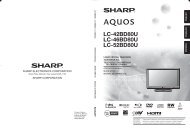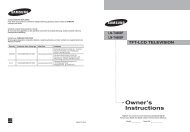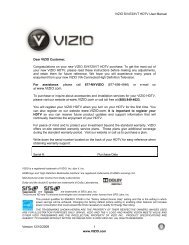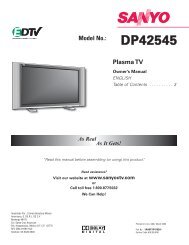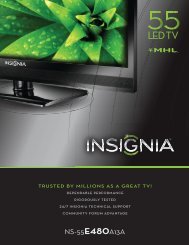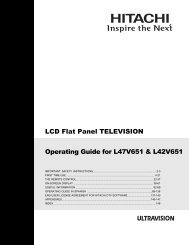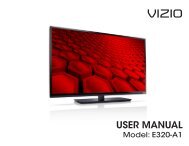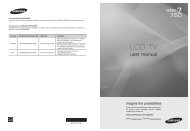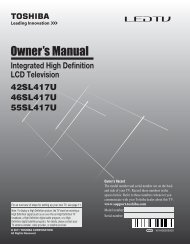LC-46D85UN LC-52D85UN - Sharp Electronics
LC-46D85UN LC-52D85UN - Sharp Electronics
LC-46D85UN LC-52D85UN - Sharp Electronics
Create successful ePaper yourself
Turn your PDF publications into a flip-book with our unique Google optimized e-Paper software.
Preparation<br />
Antennas<br />
To enjoy a clearer picture, use an outdoor antenna. The following is a brief explanation of the types of connections<br />
that are used for a coaxial cable. If your outdoor antenna uses a 75-ohm coaxial cable with an F-type connector,<br />
plug it into the antenna terminal at the rear of the TV set.<br />
1. A 75-ohm system is generally a round cable with F-type connector<br />
that can easily be attached to a terminal without tools (Commercially<br />
available).<br />
F-type connector<br />
75-ohm coaxial cable (round)<br />
2. A 300-ohm system is a fl at “twin-lead” cable that can be attached<br />
to a 75-ohm terminal through a 300/75-ohm adapter (Commercially<br />
available).<br />
300-ohm twin-lead cable (fl at)<br />
NOTICE F-type connector should be finger-tightened only.<br />
F-type connector<br />
When connecting the RF cable to the TV set, do not tighten F-type<br />
connector with tools.<br />
If tools are used, it may cause damage to your TV set. (The breaking<br />
of internal circuit, etc.)<br />
75-ohm coaxial cable<br />
Connecting Antenna Cable<br />
• Connect the antenna cable to the TV using one of the methods in the illustration as shown (1, 2, 3 or 4).<br />
1 Cable without a CATV<br />
converter<br />
2 VHF/UHF antenna<br />
Cable TV lead-In<br />
75-ohm coaxial cable (round)<br />
Home Antenna<br />
terminal (75-ohm)<br />
Coaxial cable<br />
(commercially available)<br />
Home Antenna<br />
terminal (75-ohm)<br />
3 Combination VHF/<br />
UHF antenna<br />
75-ohm coaxial cable (round)<br />
Coaxial cable<br />
(commercially available)<br />
300-ohm twin-lead cable (flat)<br />
or<br />
300/75-ohm adapter<br />
(commercially available)<br />
4 Separate VHF/UHF<br />
antenna<br />
VHF UHF<br />
ANTENNA ANTENNA<br />
or<br />
300-ohm<br />
twin-lead cable<br />
300-ohm twin-lead cable<br />
75-ohm coaxial cable<br />
IN<br />
OUT<br />
Combiner<br />
(commercially available)<br />
To TV antenna<br />
terminal<br />
Installing Batteries in the Remote Control Unit<br />
If the remote control fails to operate TV functions, replace the batteries in the remote control unit.<br />
1 Open the battery cover.<br />
2 Insert two “AAA” size batteries 3 Close the battery cover.<br />
(supplied with the product).<br />
• Place the batteries with their terminals<br />
corresponding to the (e) and (f)<br />
indications in the battery compartment.<br />
CAUTION<br />
Improper use of batteries can result in chemical leakage or explosion. Be sure to follow the instructions below.<br />
• Do not mix batteries of different types. Different types of batteries have different characteristics.<br />
• Do not mix old and new batteries. Mixing old and new batteries can shorten the life of new batteries or cause chemical leakage<br />
in old batteries.<br />
• Remove batteries as soon as they are worn out. Chemicals that leak from batteries that come in contact with skin can cause a<br />
rash. If you fi nd any chemical leakage, wipe thoroughly with a cloth.<br />
• The batteries supplied with this product may have a shorter life expectancy due to storage conditions.<br />
• If you will not be using the remote control unit for an extended period of time, remove batteries from it.<br />
8



